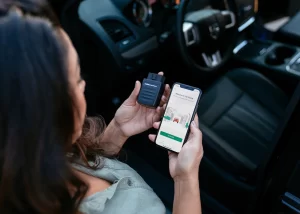Apple CarPlay and Android Auto have revolutionized in-car entertainment systems, but there’s so much more that lies ahead in terms of innovation.
Fast and ubiquitous 5G connectivity will soon bring HD screens (such as those found on vehicle windscreens) directly to vehicles, turning them into moving cinemas. It will also open up possibilities for multiplayer mobile and social gaming.
AI
Artificial Intelligence has quickly become the backbone of modern vehicle infotainment systems, replacing push buttons and swiping screens. Now more than ever before, manufacturers are using conversational AI to offer experiences that are intuitive, convenient, efficient and entertaining for drivers and passengers alike.
Voice recognition technology utilizing NLP and ML to interpret driver commands is one example of this development. Thanks to voice recognition, now you can gain access to complex vehicle data such as performance or oil levels with simple voice commands.
More advanced AI tools can identify optimal internet routes, preload content for future travel and provide personalized in-car entertainment recommendations. They can even detect when drivers become tired on long journeys and adjust music preferences accordingly or brighten interior lighting or suggest snacks – this is just the start! AI will continue empowering automotive manufacturers by speeding development cycles, increasing production efficiencies and enriching the customer experience.
Intuitive Design
No matter what they’re watching or listening to on the radio, or sending texts messages – drivers want the experience of using infotainment systems without hands-free operation and without being distracted from driving. That’s why gesture recognition will be one of 2022 and beyond’s standout innovations.
An intuitive design fosters happy users. It reduces training time, frustration and increases efficiency while simultaneously improving usability and user adoption – this is why car manufacturers are adopting intuitive technologies such as Google Assistant and Apple CarPlay so drivers have a familiar interface that seamlessly connects with their smartphone.
Automakers need to create an in-car entertainment experience that’s easy for customers to customize, such as using context-aware promotions delivered via car markers to offer more relevant and value-driven e-commerce and entertainment experiences. When approaching gas stations, petroleum companies can run contextual ads designed to entice consumers to make a purchase – engaging drivers at exactly the right moment while turning them into brand advocates.
Autonomous Driving
Autonomous driving promises to transform our understanding of cars as we know them. A new generation of autonomous cars may provide passengers with free time and the chance to indulge in entertainment such as video games or music while the vehicle drives itself.
Streaming video services have begun revolutionizing the in-car experience, making long commutes feel shorter and more engaging. They may also provide a safer alternative than hand-held mobile devices since these systems can be operated with both hands on the wheel at once.
As the automotive industry works toward perfecting autonomous driving, its effects will ripple throughout vehicle development, including user interface/user experience design. A versatile platform capable of adapting to an ever-evolving landscape will be key for both traditional OEMs and tech players; to meet these challenges successfully it’s vital that both partners collaborate on tech companies with expertise in hardware scalability as well as flexibility for innovating software development.
Personalized Experiences
Consumers have grown accustomed to seamless user experiences on mobile phones and other devices; they expect the same level of seamlessness in their car. This is especially relevant when discussing autonomous vehicles that may accommodate multiple passengers who each require different entertainment.
Example: Vehicles could learn passenger music preferences and create playlists tailored specifically to them, making long commutes or road trips more pleasurable. Furthermore, cars can provide region-specific news or traffic updates to help guide drivers safely through unfamiliar terrain.
Experiences can be seamlessly synced, using over-the-air software updates that allow your vehicle to transform into an engaging digital experience just like your phone. In doing so, the infotainment system becomes a dynamic digital environment with third-party apps providing entertainment and productivity features; further opening up opportunities for subscription-based in-car digital services that blur the line between vehicle use and your daily life.




